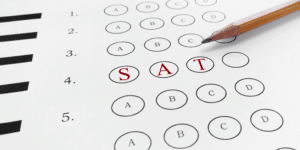If you find that a Catholic high school appeals to you or your family, then it’s very likely that an entrance exam is in your child’s future.
The Test for Admission into Catholic High Schools, or TACHS, is used for schools in the Diocese of Brooklyn and Queens, as well as the Archdiocese of New York. Read on to learn the basics of the exam, how to register, and what to expect on test day.
What’s on the TACHS?
The test is comprised of about 200 multiple-choice questions divided among four sections:
1. Reading (35 minutes)
Consists of two parts:
- Vocabulary (20 questions, 10 minutes): This section tests students’ knowledge of definitions.
- Reading Comprehension (30 questions, 25 minutes): Students demonstrate their ability to analyze text by making inferences and identifying details.
2. Language (30 minutes)
Consists of two parts:
- Spelling, Capitalization, Punctuation, and Usage/Expression (40 questions, 23 minutes): Students must show their knowledge of grammar by answering questions about sentences and paragraphs.
- Paragraphs (10 questions, 7 minutes): Students answer questions about the organization and clarity of paragraphs.
3. Mathematics (40 minutes)
Consists of two parts:
- Concepts, Data Interpretation, Problem Solving (32 questions, 33 minutes): This section includes word problems, operations, and analyses of graphs and tables.
- Estimation (18 questions, 7 minutes): Students must answer questions in which they approximate or round numbers.
4. Abilities (32 minutes)
Consists of two parts:
- Similarities and Changes (40 questions, 25 minutes): This section tests students’ ability to analyze patterns and sequences.
- Abstract Reasoning (10 questions, 7 minutes): Students make inferences and predictions about patterns.
How important is the test?
Students and families are naturally curious about how important it is to score well on the TACHS. The range of scores that schools look for will vary from place to place. The more competitive the school, the more weight it may place on your test score. TACHS results, however, are not as important as your grades or teacher recommendations.
Guidance counselors at Catholic elementary and middle schools generally have a good idea of the scores that high schools are looking for. Reach out to your guidance office, or if you do not go to a Catholic school, request a meeting at the high schools you’re interested in. They will be able to provide you with current information about the application process and their specific criteria for admitting students.
It is also important to note that a high TACHS score, in conjunction with good grades and a sound disciplinary record, may qualify a student for a scholarship.
How do I sign up?
The TACHS exam is given once a year in November, with one date for the Diocese of Brooklyn/Queens and one date for the Archdiocese of New York (check with your middle school to discuss locations for the exam). It is only open to students in eighth grade who will be high school freshmen in the following year. This means that a student can only take it once. If you don’t get the results you were hoping for, you may be able to enroll in another high school and transfer to a Catholic school later on, a process that doesn’t require repeating the TACHS.
Signing up online is the preferred method, but you can also register by calling 1-866-61TACHS or by mailing a form to the address listed at the bottom of the TACHS homepage. If you currently attend a Catholic school, the counseling office should have registration information handy as well.
After students register for the exam, they will receive an Admit Card. This card provides them with a TACHS ID (or code that identifies their test), their assigned test site, and an area to list three high schools that they want their scores sent to. A parent or guardian must sign the admit card to indicate consent for these choices.
Registration for the exam typically takes place in the fall, from August to October. For the 2016-2017 school year, there was a $63 fee; you can expect a similar fee this school year. For this payment, you will receive all of the registration materials, a student handbook, the test materials, and score reports for three high schools to which you’re applying.
Students enrolled in Catholic elementary schools do not have to worry about the Applicant Record. However, students enrolled in public, private, or non-diocesan schools must have their schools return the Applicant Record to the student’s three high school choices by the deadline. Once students who need to send in applicant records have registered for the exam, they should also be in touch with their guidance office to request that the school send out the Applicant Record, which found on the TACHS website as well as in its student handbook. The Applicant Record is a form that specifies a student’s grades, standardized test scores, attendance, conduct, and progress. This form is filled out by a teacher, counselor, or principal at your school and sent to the high schools specified on the student’s admit card.
How should I prepare?
When you register, you will receive a student handbook that contains a wealth of helpful information about the test, including what to bring, what to leave at home, and how to prepare. There is also a practice test in the back to help you familiarize yourself with the exam.
Many students participate in some form of test prep before the exam date. Because the TACHS is an admissions exam for a local area — Brooklyn, Queens, and Manhattan — test prep options tend to be offered by small companies, by tutors who specialize in the TACHS, or through Catholic elementary and middle schools’ in-house prep classes.
Another way to get around the limited TACHS-specific resources is by prepping for a more common, higher-level standardized test, since most of these exams include similar types of question and content. Joshua Abella, a student who took the test in 2014 explains, “Students should be preparing for higher-level tests, such as the SHSAT, ISEE, HSPT, and even the SAT. This is a helpful way to prepare for the TACHS exam because you are preparing for a higher-level test, so when you take the TACHS exam, it should be extremely easy.”
Noodle Pro Brendan Mernin said, “Since the TACHS is typically administered shortly after the SHSAT, prepare hard for and sit for the SHSAT because that experience will cover much of what you need to know and do for the TACHS. Of course, there are substantial differences in content, but for the parts of the tests that overlap–reading comprehension, math–as well as for the inimitable experience of sitting for a timed standardized test that counts in a place other than your own home or school, the SHSAT will get you most of the way to a great performance on the TACHS.”
There are also several TACHS prep books to choose from. Portions of “Catholic High School Entrance Exams for Dummies” are available online, including a handy cheat sheet that gives hints about what to memorize, strategies for guessing, and other helpful tips.
What should you expect on testing day?
The test begins at 9:00 a.m., but students should arrive at the test location by 8:15. The actual exam lasts two hours, but because of time budgeted for directions and other administrative tasks, students are required to remain at their testing site until 12:00 p.m.
Students are expected to bring their confirmation codes, Admit Cards, identification, and several #2 pencils. Electronic devices, other kinds of tools such as calculators or watches, scratch paper, and snacks are not permitted.
What happens to my scores?
Scores are calculated by adding one point for each correct answer and are then scaled using an algorithm written by the test’s creators.The scaled score range is between 200–800 points. Students are also sent a percentile score, which is the metric that is most often used when talking colloquially about scores.
“A good TACHS score would range from a 70 to 99. A 70 may sound low for a highly competitive entrance exam, but the average for the state and the nation is a 50,” says Joshua. He emphasizes that while there may not be a specific cut-off score that admission officers have in mind, a high TACHS score can give you the edge when many people are competing for few spots.
Score reports are delivered to high schools in December, and will be used for admissions or placement in appropriately challenging classes. High school admissions notices and home reports are sent to families in mid-January.
Related Topics:
10 Tips To Improve Your SHSAT Score
Why Good Grades Don’t Always Match Good Test Scores
You Aren’t Catholic – Attend A Catholic College Anyway
How To Prevent The Summer Slide




